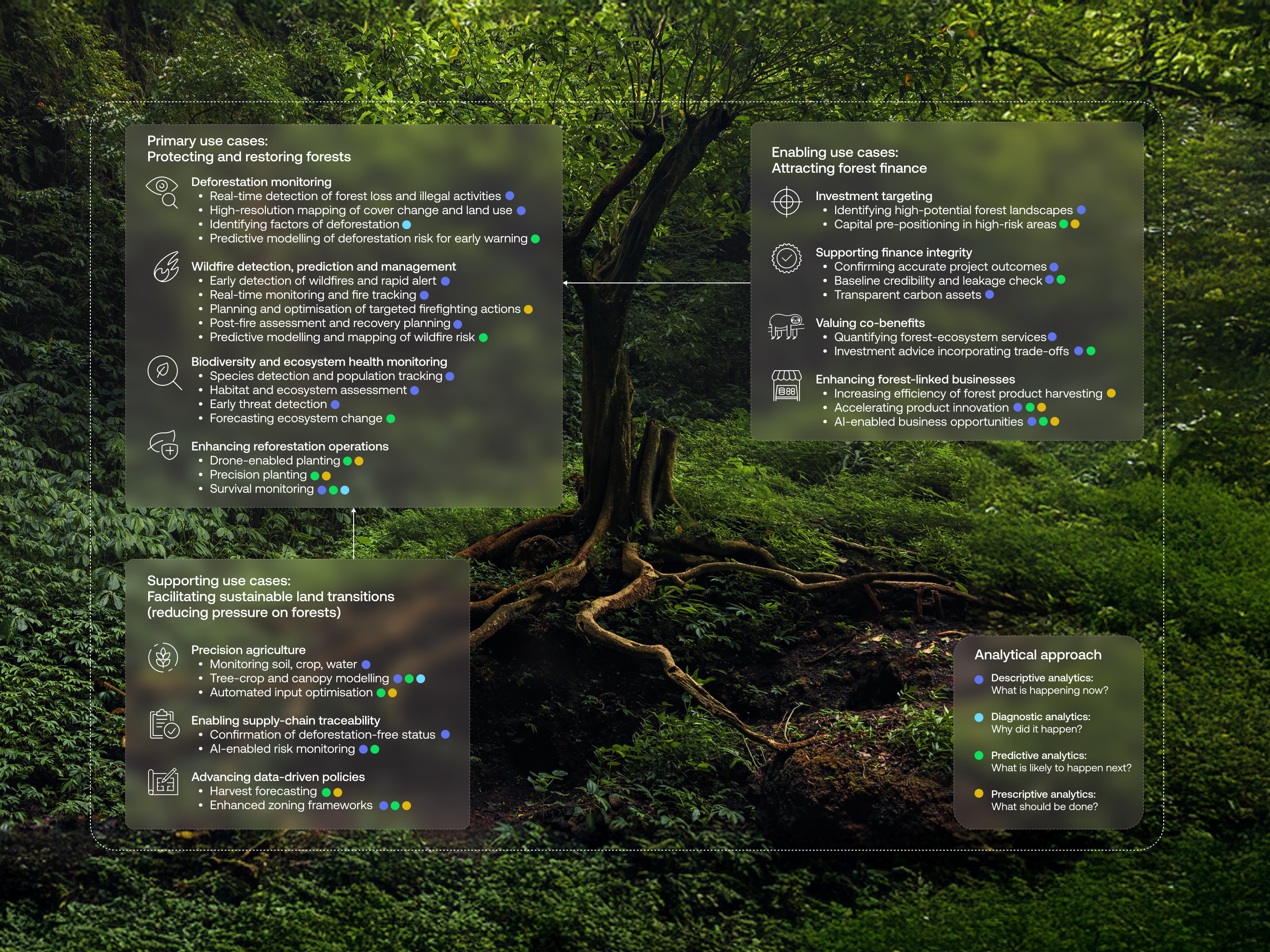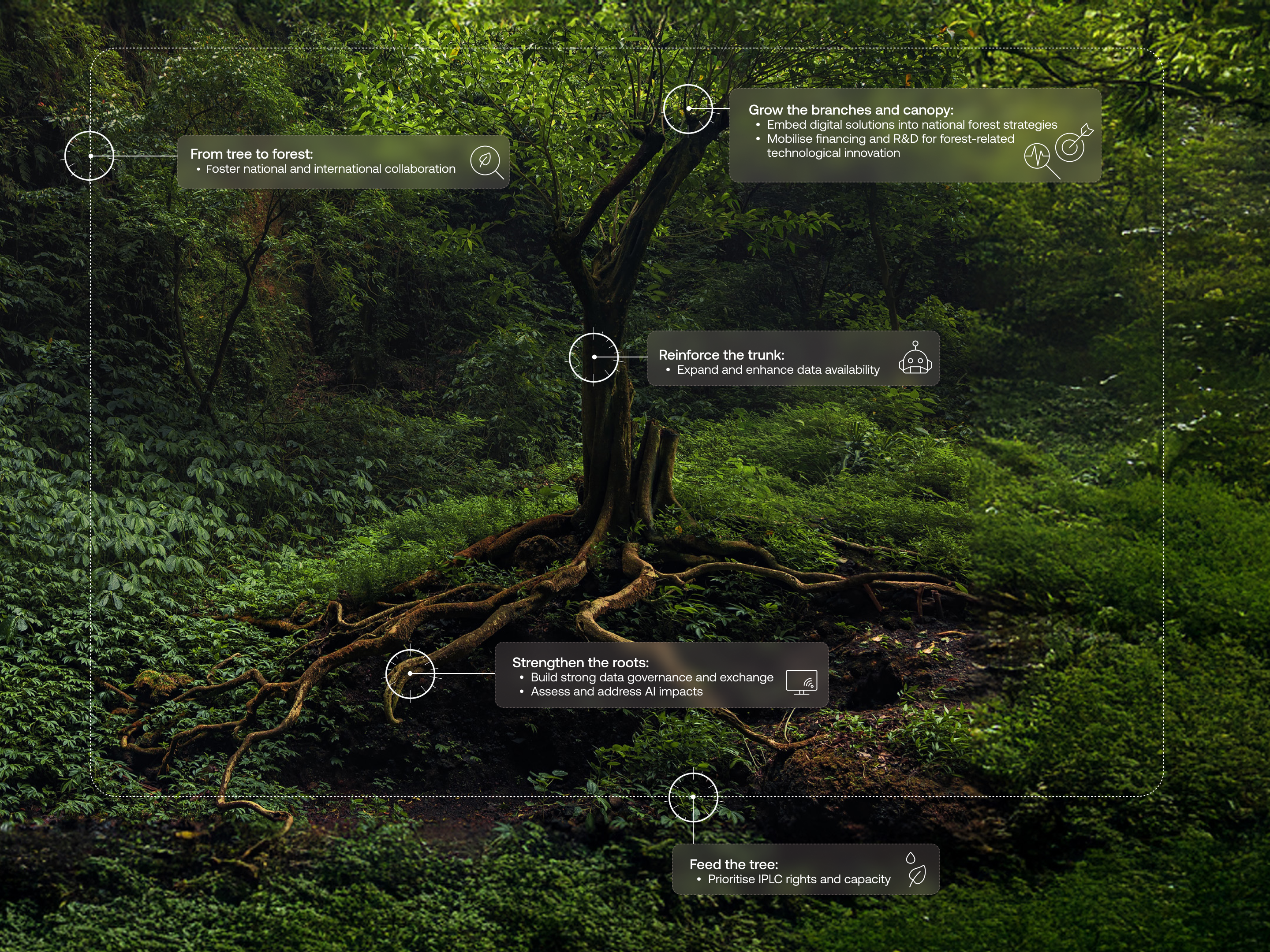In partnership with the Institute for Technology and Society of Rio de Janerio and in support of COP30.
With support and technical inputs from Fabro Steibel and Gabriella da Costa of the Institute for Technology and Society of Rio de Janeiro.
Forests are indispensable global life-support systems: they regulate our climate, purify our air and water, safeguard biodiversity, and sustain the livelihoods of millions. Yet they are vanishing at unprecedented rates. Illegal logging and mining, agricultural expansion, and climate change are degrading ecosystems and biodiversity, threatening rural livelihoods, and undermining climate stability. At the same time, rapid advances in digital technologies, particularly artificial intelligence, are opening new frontiers for conservation. While not a silver bullet, digital solutions can serve as powerful enablers, providing better understanding, faster intelligence and greater effectiveness in forest action.
The Digital Tree framework presented in this report illustrates how components of digital and AI solutions for forestry are interconnected and mutually reinforcing. The roots represent enabling foundations such as connectivity, secure data ecosystems and computing power. The trunk encompasses core technologies that transform the ways in which forest data is captured, including satellites, drones, sensors and robotics. The branches represent analytics powered by AI and machine learning (ML), which convert raw data into actionable insights for a better understanding of current forest conditions, and how to link changes to their drivers, anticipate future risks and optimise operations. The canopy represents myriad real-life applications being developed to enable stronger forest outcomes. Finally, the nutrients represent just and inclusive forest stewardship – embedding the knowledge systems of indigenous peoples and local communities (IPLC), enabling their participation in technology development and data collection, and ensuring benefits flow back to the communities that safeguard forests. This digital ecosystem is self-reinforcing, where improvements in one area strengthen the whole.
The Digital Tree Structure

Source: TBI
Digital and AI technologies are reshaping how forests are protected, managed and financed by providing faster, more accurate, and scalable tools. Together, these interventions form a canopy of solutions that strengthen conservation and restoration, enable sustainable land transitions, and unlock new avenues for sustainable forest finance. While the landscape of digital innovation is rapidly evolving, this mapping presents a curated selection of applications to illustrate the current state of practice and key directions shaping digital solutions for forests.
The Canopy of Solutions

Source: TBI
Enhanced forest conservation and reforestation: Digital and AI technologies are transforming how forests are protected and restored. Real-time monitoring and integrated data sets enable faster detection of deforestation and subtle degradation, while predictive models pinpoint high-risk areas. Wildfire management systems now combine satellites, drones and ground sensors to deliver early alerts, and support suppression and recovery. Biodiversity and ecosystem health monitoring are strengthened through bioacoustics, AI-enabled imaging and environmental DNA (eDNA), capturing critical data non-invasively. Reforestation efforts are accelerated by drone planting, with AI guiding species selection and tracking survival. Together, these tools enhance speed, accuracy and scale, empowering conservation and restoration to meet growing environmental and climate challenges.
Reduced pressure on forests through sustainable land transitions: Beyond direct forest interventions, supporting solutions are critical for addressing the pressures that drive deforestation. Despite the complex trade-offs of land-use change, digital technologies can amplify win-win opportunities for forests and development. Precision-agriculture tools optimise inputs, strengthen climate resilience and reduce the need to expand into forested areas, while traceability platforms enhance accountability across supply chains. At the policy level, geospatial and AI-based systems provide evidence for land-use planning, zoning and food-security strategies – enabling development choices that balance rural livelihoods with forest conservation. Ensuring these solutions reflect the needs of smallholders and other vulnerable groups will be key to their long-term effectiveness and equity.
Strengthened forest-finance mobilisation: Scaling digital forest solutions requires stronger and more consistent forest-positive finance, since current funding remains insufficient and continues to flow disproportionately towards activities that drive deforestation. Digital and AI technologies enhance the efficiency and credibility of forest finance by refining investment targeting, strengthening measurement, reporting and verification (MRV) of project outcomes, and improving transparency and integrity across financial flows – helping to mobilise additional capital by increasing investor confidence. They also enable the valuation of co-benefits such as biodiversity, water regulation and social outcomes, expanding the potential returns to more than just carbon. Beyond finance, digital and AI technologies are increasingly transforming forest-linked businesses at the heart of the expanding global bioeconomy.
Unlocking the full potential of technology-based solutions for forests requires coordinated action across all components of the Digital Tree. At the roots, robust data governance, interoperability and transparency frameworks are needed to build trust and scale network effects, while environmental and social impacts of emerging solutions must be addressed by ensuring responsible mineral sourcing, reducing the energy and water footprint of data centres, and embedding transparent reporting across the AI value chain. The trunk is reinforced when governments invest in large-scale, high-quality forest data collection and open-access systems – integrating satellites, unmanned aerial vehicles (UAVs), LiDAR (light detection and ranging) and field surveys – and ensure these data sets are standardised, interoperable and accessible to drive innovation and strengthen the wider digital forest ecosystem. The branches and canopy grow stronger when governments place the integration of digital and AI solutions as part of their national forest strategies – guiding efforts to create innovation hubs, support R&D, and strategically deploy blended public and private finance to de-risk early-stage ventures and create predictable revenue streams for forest projects. The nutrients feed the tree when IPLCs are empowered through rights-first, co-creative approaches that uphold data sovereignty, act to close digital divides and embed equity into forest strategies. Paired with robust international collaboration, these elements are positioned to transform fragmented pilots into scalable, credible solutions that deliver real impact for the forests and communities that rely on them.
Digital and AI technologies are rapidly expanding the frontier of what is possible for forest stewardship, yet their promise will only be realised through deliberate, coordinated and inclusive action. Many solutions remain nascent, requiring rigorous testing, high-quality data and transparent evaluation to ensure they deliver tangible results and build confidence among governments, investors and communities. To make the best use of these technologies, it will be crucial to identify where they can create the greatest impact and embed them within national forest strategies and action plans, supported by stronger international cooperation that can bridge data gaps, foster innovation, and ensure equitable access to technology and finance. Above all, digital and AI innovation must strengthen – not replace – human stewardship. When grounded in political will, secure land rights and inclusive governance, these technologies can become catalysts for more effective, equitable, and sustainable forest action – helping protect the planet’s climate, biodiversity and shared future.
Recommendations to Grow the Digital Tree

Source: TBI
Read the full report here.